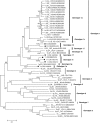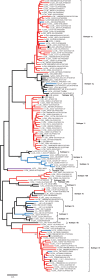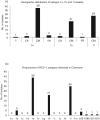Characterization of full-length hepatitis C virus sequences for subtypes 1e, 1h and 1l, and a novel variant revealed Cameroon as an area in origin for genotype 1
- PMID: 23677792
- PMCID: PMC3749522
- DOI: 10.1099/vir.0.048835-0
Characterization of full-length hepatitis C virus sequences for subtypes 1e, 1h and 1l, and a novel variant revealed Cameroon as an area in origin for genotype 1
Abstract
In this study, we characterized the full-length genome sequences of seven hepatitis C virus (HCV) isolates belonging to genotype 1. These represent the first complete genomes for HCV subtypes 1e, 1h, 1l, plus one novel variant that qualifies for a new but unassigned subtype. The genomes were characterized using 19-22 overlapping fragments. Each was 9400-9439 nt long and contained a single ORF encoding 3019-3020 amino acids. All viruses were isolated in the sera of seven patients residing in, or originating from, Cameroon. Predicted amino acid sequences were inspected and unique patterns of variation were noted. Phylogenetic analysis using full-length sequences provided evidence for nine genotype 1 subtypes, four of which are described for the first time here. Subsequent phylogenetic analysis of 141 partial NS5B sequences further differentiated 13 subtypes (1a-1m) and six additional unclassified lineages within genotype 1. As a result of this study, there are now seven HCV genotype 1 subtypes (1a-1c, 1e, 1g, 1h, 1l) and two unclassified genotype 1 lineages with full-length genomes characterized. Further analysis of 228 genotype 1 sequences from the HCV database with known countries is consistent with an African origin for genotype 1, and with the hypothesis of subsequent dissemination of some subtypes to Asia, Europe and the Americas.
Figures




References
Publication types
MeSH terms
Substances
Associated data
- Actions
- Actions
- Actions
- Actions
- Actions
- Actions
- Actions
Grants and funding
LinkOut - more resources
Full Text Sources
Other Literature Sources
Molecular Biology Databases
Research Materials

